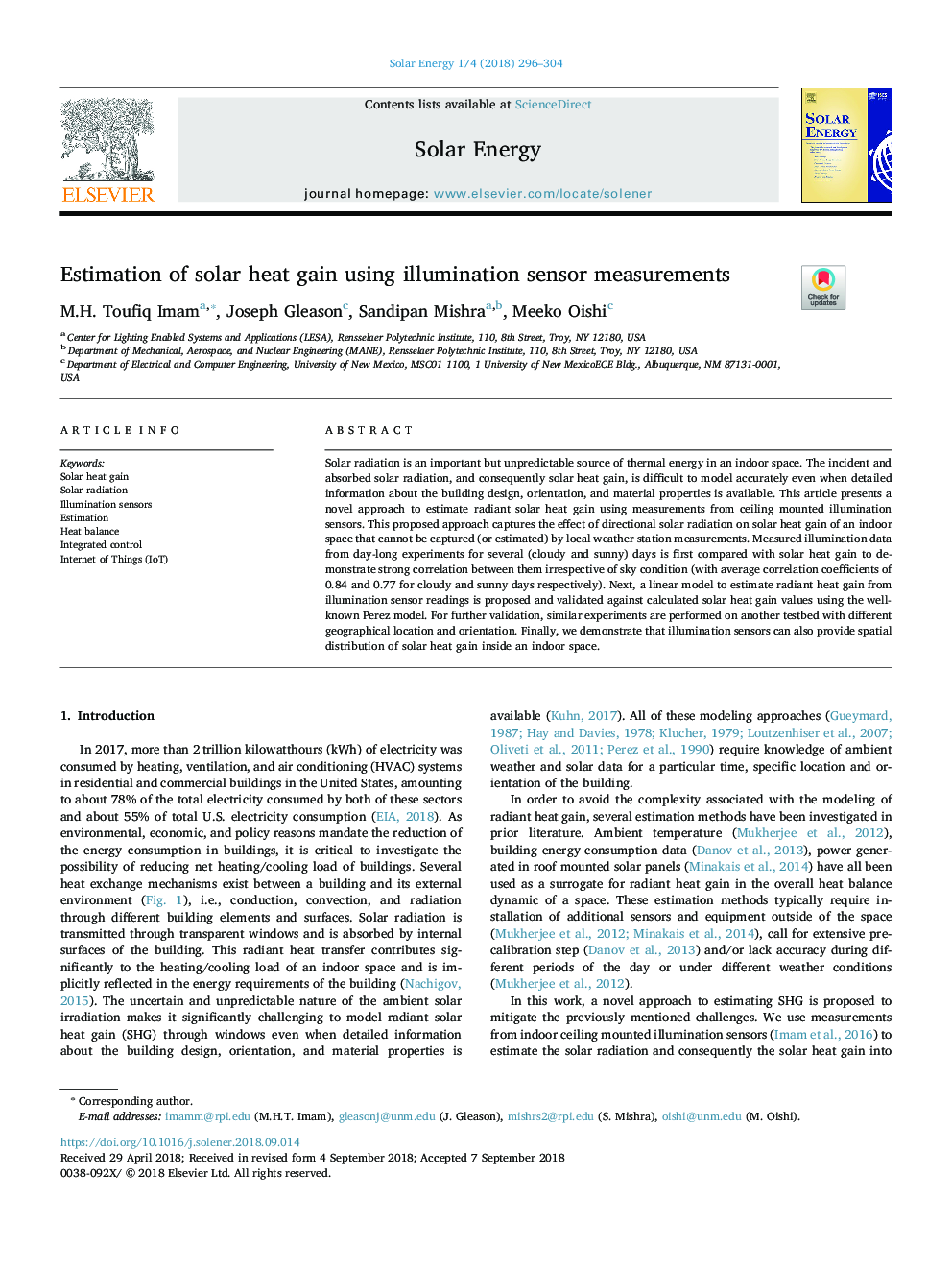| کد مقاله | کد نشریه | سال انتشار | مقاله انگلیسی | نسخه تمام متن |
|---|---|---|---|---|
| 10141955 | 1646086 | 2018 | 9 صفحه PDF | دانلود رایگان |
عنوان انگلیسی مقاله ISI
Estimation of solar heat gain using illumination sensor measurements
ترجمه فارسی عنوان
برآورد گرمای خورشیدی با استفاده از اندازه گیری های حسگر نور
دانلود مقاله + سفارش ترجمه
دانلود مقاله ISI انگلیسی
رایگان برای ایرانیان
کلمات کلیدی
ترجمه چکیده
تابش خورشیدی یک منبع مهم و غیر قابل پیش بینی انرژی حرارتی در یک فضای داخلی است. حادثه و جذب تابش خورشید و در نتیجه افزایش گرمای خورشید دشوار است حتی اگر اطلاعات دقیق در مورد طراحی ساختمان، جهت گیری و خواص مواد در دسترس باشد دشوار است. این مقاله روشی جدید برای ارزیابی گرمای تابشی خورشیدی با استفاده از اندازه گیری از سنسورهای روشنایی سقف نصب شده ارائه می دهد. این روش پیشنهادی، تأثیر تابش خورشیدی مستقیم بر افزایش گرمای خورشید فضای داخلی است که نمیتواند توسط (یا تخمین) اندازه گیری های ایستگاه آب و هوایی محلی گرفته شود. داده های روشنایی اندازه گیری شده از آزمایشات روزانه برای چندین روز (ابری و آفتابی) برای مقابله با افزایش گرمای خورشیدی برای نشان دادن همبستگی قوی بین آنها بدون در نظر گرفتن شرایط آسمان (با میانگین ضریب همبستگی 0.84 و 0.77 در روزهای آفتابی و آفتابی) مقایسه می شود. سپس، یک مدل خطی برای برآورد میزان جذب تابشی از خواندن سنسورهای روشنایی پیشنهاد شده و برای مقادیر به دست آمده از انرژی خورشیدی محاسبه شده با استفاده از مدل شناخته شده پرز پیش بینی شده است. برای اعتبار سنجی بیشتر، آزمایش های مشابه بر روی تست دیگری با مکان و موقعیت جغرافیایی مختلف انجام می شود. در نهایت، ما نشان می دهیم که سنسورهای نور نیز می توانند توزیع فضایی گرمای خورشیدی را در داخل فضای داخلی فراهم کنند.
موضوعات مرتبط
مهندسی و علوم پایه
مهندسی انرژی
انرژی های تجدید پذیر، توسعه پایدار و محیط زیست
چکیده انگلیسی
Solar radiation is an important but unpredictable source of thermal energy in an indoor space. The incident and absorbed solar radiation, and consequently solar heat gain, is difficult to model accurately even when detailed information about the building design, orientation, and material properties is available. This article presents a novel approach to estimate radiant solar heat gain using measurements from ceiling mounted illumination sensors. This proposed approach captures the effect of directional solar radiation on solar heat gain of an indoor space that cannot be captured (or estimated) by local weather station measurements. Measured illumination data from day-long experiments for several (cloudy and sunny) days is first compared with solar heat gain to demonstrate strong correlation between them irrespective of sky condition (with average correlation coefficients of 0.84 and 0.77 for cloudy and sunny days respectively). Next, a linear model to estimate radiant heat gain from illumination sensor readings is proposed and validated against calculated solar heat gain values using the well-known Perez model. For further validation, similar experiments are performed on another testbed with different geographical location and orientation. Finally, we demonstrate that illumination sensors can also provide spatial distribution of solar heat gain inside an indoor space.
ناشر
Database: Elsevier - ScienceDirect (ساینس دایرکت)
Journal: Solar Energy - Volume 174, 1 November 2018, Pages 296-304
Journal: Solar Energy - Volume 174, 1 November 2018, Pages 296-304
نویسندگان
M.H. Toufiq Imam, Joseph Gleason, Sandipan Mishra, Meeko Oishi,
